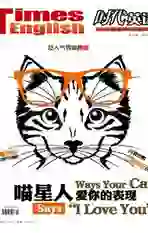跟踪导练(四)3
2016-09-21
阅读理解
A
It is a great, big, wide-open sky over our heads, but when you are flying in a jet airliner at 600 miles an hour, the sky is not so big. Thats part of the reason why, in the first four months of this year, the government said only 72 percent of all flights arrived on time, the lowest number since the recent system of reporting began in 1995.
The runways are full, the planes are jammed, and air traffic controllers complain theyre stressed out. And the radar systems that keep things going are, in large part, technology of the 1960s. “Its like driving down the road with a paper bag over your head, and youre trying to stay out of the way of other cars,” says Captain Karen Lee, a 747 pilot who heads operations for UPS, the delivery service.
At its center in Louisville, UPS is experimenting with the next generation in air traffic control: planes guided by the satellites of the Global Positioning System, instead of radar.
Though it has advanced greatly over the years, radar is a technology that dates back to World War II. It scans the sky, looking for signals from planes in the air. Typically, air traffic radar only updates a planes position once every 12 seconds or so — and in 12 seconds, a jet can move two miles or make a turn. Whats more, radar signals can be blocked by storms or mountains. But with GPS signals, pilots can see in real time exactly where they are, and where other planes are, too. A readout screen in the cockpit (驾驶舱) tells the pilots whats around them.
“What we end up with is a very exact location for each aircraft in the system,” said Basil Barimo of the Air Transport Association, which represents airlines.
1. Whats the main cause of the jamming of planes?
A. Planes fly very fast.
B. The control system has fallen behind.
C. The number of planes is increasing too fast.
D. The weather has become worse these years.
2. What will be used to solve the jamming of planes?
A. A readout screen in the cockpit.
B. A more advanced radar system.
C. A Global Positioning System.
D. A new satellite.
3. What is the disadvantage of the present radar system according to the text?
A. It sometimes loses objects.
B. It often provides unclear pictures.
C. It cannot help pilots know where they are.
D. Its signals may be limited for certain reasons.
4. It can be inferred that what matters most in the air is for the pilots ___ .
A. to see the planes around
B. to communicate with the ground
C. to control the speed of the planes
D. to know exactly the position of each other
B
In 1901, H. G. Wells, an English writer, wrote a book describing a trip to the moon. When the explorers landed on the moon.They discovered that the moon was full of underground cities. They expressed their surprise to the “moon people” they met. In turn, the “moon people” expressed their surprise. “Why,” they asked, “are you traveling to outer space when you dont even use your inner space?”
H. G. Wells could only imagine travel to the moon. In 1969, human beings really did land on the moon. People today know that there are no underground cities on the moon. However, the question that the “moon people” asked is still an interesting one. A growing number of scientists are seriously thinking about it.
Underground systems are already in place. Many cities have underground car parks. In some cities, such as Tokyo, Seoul and Montreal, there are large underground shopping areas. The “Chunnel”, a tunnel (隧道) connecting England and France, was completed.
But what about underground cities? Japans Taisei Corporation is designing a network of underground systems called “Alice Cities”. The designers imagine using surface space for public parks and using underground space for flats, offices, shopping, and so on. A solar dome (太阳能穹顶) would cover the whole city.
Supporters of underground development say that building down rather than building up is a good way to use the earths space. The surface, they say, can be used for farms, parks, gardens, and wilderness, H. G. Wells “moon people” would agree. Would you?
5. The explorers were surprised to find that the “moon people” ___ .
A. understood their language
B. knew so much about the earth
C. lived in so many underground cities
D. were ahead of them in space technology
6. What does the underlined word “it” in Paragraph 2 refer to?
A. Traveling to outer space.
B. Using the earths inner space.
C. Meeting the “moon people” again.
D. Discovering the moons inner space.
7. What sort of underground systems have been used by us?
A. Tunnels, gardens, offices.
B. Tunnels, car parks, shopping areas.
C. Gardens, car parks, power stations.
D. Offices, shopping areas, power stations.
8. What would be the best title for the passage?
A. Alice Cities—Cities of the Future
B. Space Travel with H. G. Wells
C. Enjoy Living Underground
D. Building Down, Not Up
